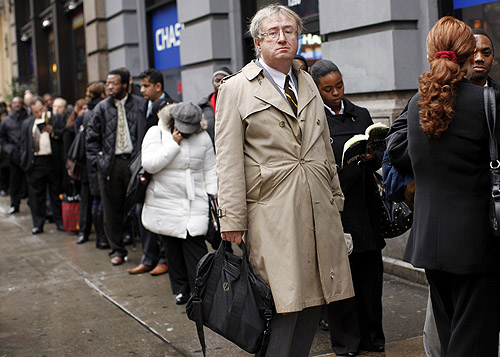|
 |
|
PLEASE HELP: Unemployed Americans queue at a job fair in New York on December 9, 2009 (XINHUA) |
In 2010, hopefully, the world economy will emerge from recession and progress toward an overall recovery. But the process will be anything but easy—and, if nothing else, replete with abundant uncertainties.
Slowest recovery
Last year was the first time the world economy experienced negative growth since the end of World War II. In fact, according to data from the International Monetary Fund (IMF), the growth rate of the global GDP in 2009 was negative 1.1 percent—a sharp drop compared with 5.2 percent in 2007.
Thanks in no small part to policy coordination and a series of large-scale economic stimulus packages, industrial countries, such as the United States, those of the eurozone and Japan, as well as the world economy at large, began to step out of the recession in the second half of 2009.
Consequently, the IMF projected that the growth rate of the global GDP would increase to 3.1 percent in 2010.
This recovery has been predicted to bear far different characteristics from previous ones. Indeed, it may well be the slowest one since the end of World War II.
In the United States for example, in the following year after each recession, America's GDP growth has always rebounded sharply, illustrated on charts by a "V" shape.
The average GDP growth rate in the United States was 6.2 percent in the first four quarters after the recession of 1973-75. The figure stood at 7.7 percent in the first four quarters after the 1981-82 recession. But following the 2008-09 recession, the average annual GDP growth rate is projected at lower than 3 percent in the United States.
This recovery therefore may well resemble something akin to a Nike logo on data charts. Worse still is the fact that it not be accompanied by an increase in employment.
Also noteworthy is the fact that this recovery is being led by emerging economies in Asia. Since World War II, economic recoveries have traditionally been led by the United States and Europe. After that, developing countries recovered under their umbrella.
This time, however, Asia's emerging economies recovered first. These nations not only enjoyed the highest growth rates, but also made the most significant contributions to world economic growth.
But there remain great uncertainties within the scope of this global recovery. Currently, the recovery mainly emanates from the large-scale economic stimulus packages carried out by governments. That is, this latest growth is not motivated by the economies themselves.
This year, not surprisingly, the world economy faces many risks. In the previous recoveries, developed countries usually witnessed a surge in spending. This time, though, developed countries, led by the United States, adjusted their growth mode through increasing savings and reducing consumption. This will inevitably lead to a weak, and even a shrinking, global demand.
What's more, the surplus of production capacity remains severe in developed countries. Meanwhile, the bank credit continues to tighten.
Consequently, fixed asset investments—the foundation of economic recoveries—are unlikely to rebound as quickly as before.
Still, the handling of huge toxic assets and the adjustment of balance sheets remain incomplete within many major U.S. and European financial institutions. This only adds to the difficulties.
The major economies also face a serious dilemma when it comes to putting a brake on stimulus policies. If they stop their stimulus packages too early, the recovery will die prematurely; if too late, inflation and asset bubbles will be exacerbated.
In the end, if these countries cannot effectively transfer economic recovery from government-driven growth to self-sustaining growth, they will not be able to achieve the means to support a real global economic recovery.
Financial risks
Since the second quarter of 2009, the international financial situation has stabilized. However, a number of risks will continue to constrain the vitality of the financial market over the course of this year.
Housing market in the United States and Europe, very importantly, has yet to fully stabilize. Many banks have gone bankrupt, too. In 2009, more than 140 American banks declared bankruptcy—nearly five times more than that of the previous year. At present, there are still more than 550 "problem banks" in the United States.
There is also the hidden risk in the explosion of bubbles in either housing markets or stock markets in many parts of the world. Potential dangers include the debt crisis of the Dubai World Company in the United Arab Emirates, as well as the debt crises facing Spain, Greece, Portugal and Austria, among other EU countries. They may well cause new fluctuations in the international financial system.
Growing protectionism
World trade has been severely shattered by the international financial crisis and the global economic recession. According to the World Trade Organization (WTO), world trade volume plummeted by 40 percent in the first quarter of 2009.
In the second quarter, meanwhile, although the situation began to improve, the rate of decrease remained in the double-digits. The WTO predicted that world trade volume would decrease by 10 percent in 2009.
According to the IMF, world trade volume is expected to increase by 2.5 percent in 2010—far less than 7.3 percent in 2007.
In addition to the slow economic recovery and developed countries' reduction of imports in order to decrease consumption and foster savings, trade protectionism has also proven a huge threat to the recovery of international trade.
| 